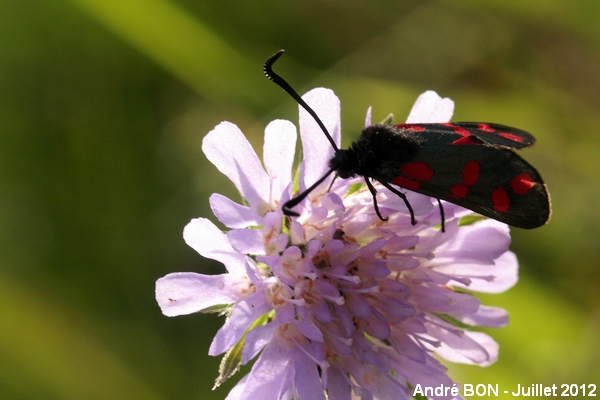








| Southern Six-spot Burnet (Zygaena transalpina (Esper, 1780)) |









|
|
Scientific name: Zygaena transalpina (Esper, 1780) Common name: Southern Six-spot Burnet French name: Zygène transalpine Order: Lepidoptera Suborder: Heterocera Family: Zygaenidae Subfamily: Zygaeninae Wingspan: 30 mm. Biotope: Dry meadows with flowers. Geographic area: Southern Europe, east to Croatia. Flight time: June to August. Number of generations : 1 Caterpillar: Greenish yellow with two black spots per segment (the hind spot triangular). There may be a black dorsal line which is sometimes missing. Host plant: Horseshoe Vetch (Hippocrepis comosa) and sometimes Crown Vetch (Securigera varia) and Bird's-foot Trefoil (Lotus corniculatus). |
The forewings of the Southern Six-spot Burnet are a greyish-blue or dark green colour. There are six red spots, grouped by pairs and clearly visible. The spots are generally well separated but there are variants with touching spots. The red colour of the underside of the fore wings, with sharp edges, covers and hides all the spots. The hind wings are red with a black border showing one tooth in its middle. There is no red ring on the abdomen. The tip of the antennae is white or yellowish. Both sexes are similar. The Southern Six-spot Burnet overwinters as a caterpillar. The Six-spot Burnet (Zygaena filipendulae) may also show six well separated red spots. You can tell it apart with the black tip of the antennae or with the underside of the fore wings where the spots are clearly visible and well separated. Zygaena ephialtes shows a well marked red abdominal ring. The black border of the hind wings is wider. |
| [To know more about the Southern Six-spot Burnet] [Next picture] [Top] |

|
The whitish tip of the antennae is clearly visible on this picture. |
| [To know more about the Southern Six-spot Burnet] [Next picture] [Previous picture] [Top] |

|
In the Paris area, I have shot all my pictures of Southern Six-spot Burnets in the same small corner of a dry meadow with flowers. |
| [To know more about the Southern Six-spot Burnet] [Next picture] [Previous picture] [Top] |

|
You can guess the whitish tip of the antennae and the tooth on the black border of the hind wings is visible on this picture (to be replaced by a sharper one as soon as I have one). |
| [To know more about the Southern Six-spot Burnet] [Next picture] [Previous picture] [Top] |

|
Mating. The species identification is based on the pale colour of the tip of the antennae. |
| [To know more about the Southern Six-spot Burnet] [Next picture] [Previous picture] [Top] |

|
Mating. |
| [To know more about the Southern Six-spot Burnet] [Next picture] [Previous picture] [Top] |

|
The hippocrepidis subspecies is characterized by a smaller size. Based on this, the wings' spots appear larger and those close to the tip of the wing are almost touching each other. The tooth appearing on the hind wing's black border is a very small size. |
| [To know more about the Southern Six-spot Burnet] [Next picture] [Previous picture] [Top] |

|
Another view of the same specimen. |
| [To know more about the Southern Six-spot Burnet] [Next picture] [Previous picture] [Top] |

|
It is difficult, and even impossible, to tell apart caterpillars of the Southern Six-spot Burnet species, the Six-spot Burnet species (Zygaena filipendulae) and Zygaena ephialtes on picture. I have listed this one as Southern Six-spot Burnet because I am used to observing many imagos of this species at this place and I have never seen the other species here. |
| [To know more about the Southern Six-spot Burnet] [Previous picture] [Top] |

|
Close-up view. |